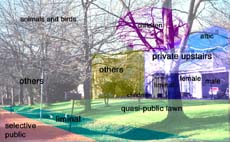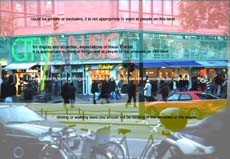index
What place grammars do
click on images for full-size:




Suburban space divisions

Suburban space norms

Spatial divisions on the Kurfurstendam, Berlin
Place grammars specify types of things and movements and locations, along with their appropriate placements and borders and transitions and performances. The most elaborate and explicit place grammars are at thickly ritualized sites such as a parliament hall, a church, or a courthouse. There is a directionality to movement in these places; there are crossings where one moves into a new sub-place; there are norms about what parts are in the same sub-place; there are some actions done here, others there, and some done by transitions from here to there; there are items that should or should not be present; there are possible changes that make or don't make sense in the place. Such highly ritualized places are more exacting than less formal locations, but "less formal" is itself a normative category, not an absence of normative categories. A house, a street, a park, a family room, each has its own map and its own choreography. In making (or remaking or continuing) a place, different regions of what surrounds us are distinguished. Different actions and stages of actions are distinguished. Normative correlations are set up between these sets of distinctions. Making distinctions, making combinations, and making norms all happen in a mutual emergence, each taking cues from the other. A place offers a spatial landscape of action possibilities. [Objection!]